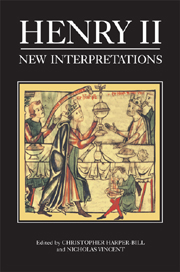Book contents
- Frontmatter
- Contents
- List of Illustrations
- Editor's Preface
- List of Abbreviations
- Introduction: Henry II and the Historians
- The Accession of Henry II
- Henry II and Louis VII
- Doing Homage to the King of France
- Henry, Duke of the Normans (1149/50–1189)
- Henry II and England's Insular Neighbours
- Henry II, the English Church and the Papacy, 1154–76
- On the Instruction of a Prince: The Upbringing of Henry, the Young King
- Henry II and the Creation of the English Common Law
- Finance and the Economy in the Reign of Henry II
- Henry II and the English Coinage
- The Court of Henry II
- Literary Culture at the Court of Henry II
- Henry II and Arthurian Legend
- Index
The Accession of Henry II
Published online by Cambridge University Press: 12 September 2012
- Frontmatter
- Contents
- List of Illustrations
- Editor's Preface
- List of Abbreviations
- Introduction: Henry II and the Historians
- The Accession of Henry II
- Henry II and Louis VII
- Doing Homage to the King of France
- Henry, Duke of the Normans (1149/50–1189)
- Henry II and England's Insular Neighbours
- Henry II, the English Church and the Papacy, 1154–76
- On the Instruction of a Prince: The Upbringing of Henry, the Young King
- Henry II and the Creation of the English Common Law
- Finance and the Economy in the Reign of Henry II
- Henry II and the English Coinage
- The Court of Henry II
- Literary Culture at the Court of Henry II
- Henry II and Arthurian Legend
- Index
Summary
Henry, duke of Normandy, arrived in England within the octave of the Epiphany 1153, and came to church to pray the mass ‘after the manner of military men’. The clerk intoned the introit, ‘Ecce advenit dominator Dominus: et regnum in manu eius, et potestas, et imperium (See he comes, our Lord and Ruler, armed with royal power and dominion.)’, and again: ‘Grant to the king, O God, your own skill in judgement; to the inheritor of a throne, may he be just, as you are just.’ Within the octave of the Epiphany a year later, ‘King Stephen and his new son’ (as Henry had now become) met at Oxford, by which time ‘the duke had already spent almost a year in the conquest, or rather the resuscitation, of England. There, at the king's command, the English magnates paid to the duke the homage and fealty due to their lord, but they were to maintain the honour and faith due to the king while he lived.’ During these twelve months the accession of Henry II was settled; settled on terms that Stephen was prepared to accept; settled on terms that the political community of England was also prepared to accept. A conquest it was not.
This was not what Henry had wanted, nor was it what most political commentators had expected. It was remarkable, said Ralph de Diceto, that the conflict was not settled by force of arms. Twice in 1153 a confrontation was set up. The first occasion was at Malmesbury in Wiltshire, perhaps in late February, when both king and duke had their key supporters with them.
- Type
- Chapter
- Information
- Henry IINew Interpretations, pp. 24 - 46Publisher: Boydell & BrewerPrint publication year: 2007



